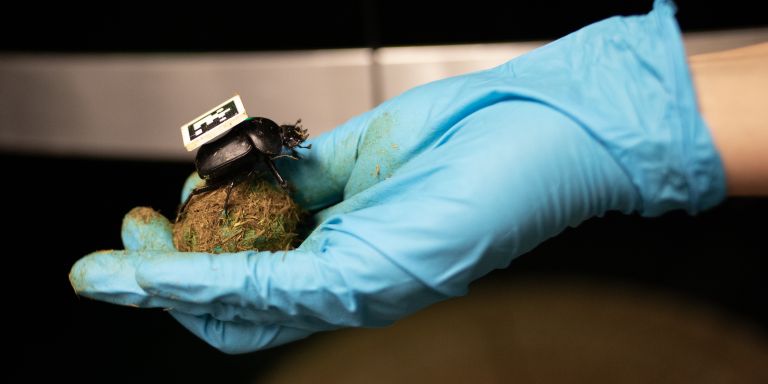
Marie Dacke
Professor of Sensory Biology
Wallenberg Scholar
Institution:
Lund University
Research field:
Biological and artificial navigation systems


Wallenberg Scholar
Institution:
Lund University
Research field:
Biological and artificial navigation systems
Dacke, who is a Wallenberg Scholar and professor of sensory biology at Lund University. She has just received a new consignment of dung beetles from Sardinia. She mostly uses dung beetles from South Africa, but she can carry out her studies all year round by using insects from around the globe.
There are many species of dung beetle; they all live on animal feces. About one-tenth of the species make dung into balls, which they then roll backward, away from the competition. When they have gone far enough, they burrow into the ground and feast on the ball. These are the kind of dung beetles that Dacke is working with. Her goal is to understand how they navigate.
“Dung beetles are highly mobile when they are rolling the ball – the terrain may be uneven, the sun may be obscured by clouds, woodland trees may block out the sky. Yet still they manage to steer a straight course. We want to understand how they receive and process signals with their eyes and their antennae – how they select information that is relevant and reliable, and process it.”
Over the past twenty years Dacke and her colleagues have made multiple discoveries about dung beetle navigation systems. For instance, species that roll dung balls at night can navigate by the Milky Way, and with the help of polarized moonlight.
“We’ve recently been studying how dung beetles combine different types of directional information. For example, they use both light and wind, even though wind is a very ‘noisy’ and variable source of information. We want to understand how they do it, and what the underlying neurobiology is.”
The researchers are using a wide range of methods – from minute electrodes that measure activity in beetle neurons, to holding up an Ikea mirror.
“One of our most frequently used pieces of equipment in the field is a 30cm x 30cm mirror normally used to make mirrored walls. We use the mirror and a shade board to ‘move the sun,’ while the wind continues to blow in the same direction.”
Experiments of this kind can be carried out with greater accuracy in the laboratory, where light and wind can be controlled. One experiment involves attaching tiny patterned tiles to the beetle’s back so that a camera can register their direction and adapt the position of the artificial sun to the movements of the insect.
Advanced imaging equipment is being used to study the internal workings of the insects, right down to individual connections between neurons in the beetle’s brain.
But field studies are also important to see how the beetles behave in their natural environment. Trials are taking place in Lund to develop electronic equipment light enough to be carried by the beetles in the wild like a mini-backpack.
“This is possible because dung beetles are so large – one of the reasons they make a good experimental subject. I’m not really an entomologist – I use dung beetles as my model animals to learn more about biological compasses,” Dacke explains.
In the lab the beetles are supplied with information that is “noisy” in a way rigorously controlled by the researchers. This enables them to ascertain whether the beetles are using a mean value of the information, whether they can assess the reliability of each source, or whether they perhaps take into account their own bodily movements. The researchers do not know the answer to any of these questions yet.
“When we present the beetles with conflicting sources of information, the course they take gives us the answers. Do they turn around, go forward, or consistently take the wrong route?”
The findings from the beetle experiments may benefit robot systems of the future. Robots also need to cope with uneven and changeable environments. At present this necessitates complex software and requires copious energy. The insects have developed intelligent solutions requiring very few calculations. This makes the process quick and energy-efficient, which is of great interest in the field of robotics and artificial intelligence.
Any machine that is designed to move freely through its surroundings has to gather large quantities of information. Insects often have intelligent, fast and energy-efficient ways of doing this.
Dacke and her fellow researchers will use the knowledge gained from the beetle experiments to build an electronic circuit and test it in a robot. If the robot’s ability does not equal that of the beetle, the team will know they have missed something. They will then go back to look for more information, modify the robot, and try again. Their work oscillates between the lab and field, between machine and animal.
As a young girl Dacke was fascinated by animals. She had “a thousand pets – snail farms and so on.” Studying biology came naturally to her; her first research project was about spiders’ vision. She later accompanied a fellow PhD student to South Africa, where she saw dung beetles and realized how interesting it would be to study them. She still carries out field studies for nearly two months each year – she thinks the most unexpected behaviors are found in nature:
“Every time I’ve said I’m going to start using another model system, I discover something new about dung beetles that generates another five years’ research. Ten years ago I found out they use the Milky Way – something we really hadn’t expected. So I’ll probably still be studying dung beetles in ten years’ time, although I can’t say exactly how. You can’t find the unknown by actively looking for it. It’s really hard – but such fun.”
Text Lisa Kirsebom
Translation Maxwell Arding
Photo Åsa Wallin